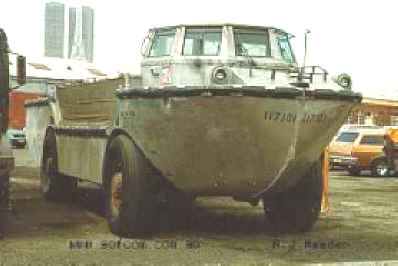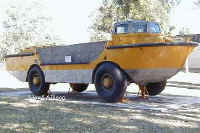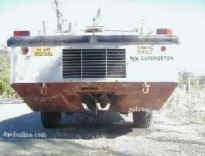 |
|
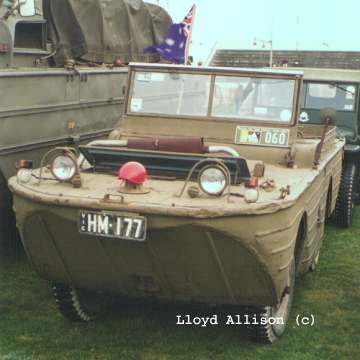 |
The
amphibious Jeep or Seep
was inspired by the much larger DUKW. More
properly it is a Ford GPA (G: Government, P: 80"
wheelbase, A: Amphibian), based on the standard world war II
Jeep.
A simple hull was wrapped around the Jeep chassis. A propeller is driven from the transfer-case power take off unit.
|
| The other
"propeller" shafts to the front and rear axles are enclosed
in water proof tubes, sealed by flexible gaiters to the hull and to
the differentials to allow normal suspension movement. These and other
modification pushed the weight up to 1600kg (3600lbs). The cockpit has
more control levers than you can poke a stick at: 2WD/4WD, hi-range/
lo-range, capstan winch (on the bows), rudder and propeller.
The Seep's intended use was to ferry soldiers to and from ships off-shore, to trundle up the beach and continue inland. They were not very successful. It had been planned to build 12,000 of them (Clayton '82) but only 5,000 were produced (Carlin '89), all by Ford. It is reported that many of the Jeeps that were used in battle sank if there were any significant waves at all. Nevertheless, a highly modified amphibious Jeep called `Half-Safe' crossed the Atlantic ocean in 1950 and continued on to circle the world - L. Allison Ford GPA Specifications
Half Safe (another mad Aussie?)Frederick Benjamin (Ben) Carlin (1912-1981) was born in Northam, Western Australia. He had seen amphibious Jeeps in India during the war and decided that one could drive, and swim, around the world. After the war he fetched up in America and determined to buy a Jeep and to make such a trip. He also married Elinore, an American, who despite being highly susceptible to sea-sickness set out with him. They had considerable trouble in obtaining an amphibious Jeep, a 1942 Ford GPA number 1239, and in making it serviceable, or at least `Half Safe'. A more boat-like bow was added, as well as a cabin, and an under-belly fuel tank that could be jettisoned when empty. Standard Jeeps were open and many of them had sunk but the addition of a cabin kept the water out and made up for the low freeboard. The first leg of the world trip was the crossing of the Atlantic, leaving from Halifax, Nova Scotia. The initial attempt, in 1949, ended ignominiously with rescue after a propeller-shaft bearing failed; an amphibious Jeep has a real propeller-shaft of course. The second attempt, leaving in July 1950, was successful although full of interest and incident as recounted in Ben Carlin's first book. They stopped en-route at the Azores, Madeira and the Canary Isles before landing at Cape Juby in Morocco. The book leaves the Jeep in England and in need of much work. The effects of corrosion had to be repaired and the superstructure was improved. The book must have provided much needed finance because the rest of the trip was completed not in luxury but with fewer worries about money. The Carlins and the Jeep made the crossing to France on 22 April 1955. Their route took them through Europe, Iraq, Persia, Pakistan and India. They shipped the Jeep from Calcutta to Perth so that they could tour Australia, including a visit to Guildford Grammar, Ben Carlin's old school. The Jeep was then returned to Calcutta so that it could resume the circumnavigation on its own wheels and hull. Elinore returned to the US at this point and Ben Carlin continued with various adventurers. The Jeep sailed to Burma and drove overland to Thailand Cambodia and Vietnam. It then sailed to Japan via Hong Kong, Taiwan and Okinawa. Leaving Japan, it set out on the last long ocean leg - to the Aleutian Islands (7 July 1957) and Alaska. On 13 May 1958 the Jeep finally drove into Montreal where the project had started. It had covered "9,600 nautical miles by water and 39,000 miles overland" by Carlin's reckoning. The book of the second half of the trip was not published until 1989 after Carlin's death in 1981. Half Safe now resides at Guildford Grammar school. The Jeep has been restored and is on-show in a special glass-walled garage where visitors can look and wonder - L. Allison http://www.csse.monash.edu.au/~lloyd/4/Ford/GPA/
|
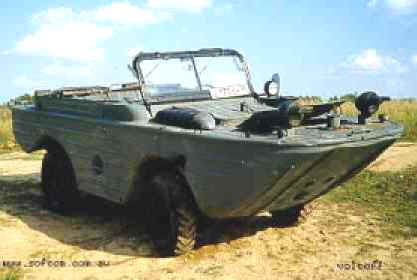 |
A 1953 GAZ 46 (MAV) amphibious Jeep, inspired by the war-time amphibious Jeep or Seep. |
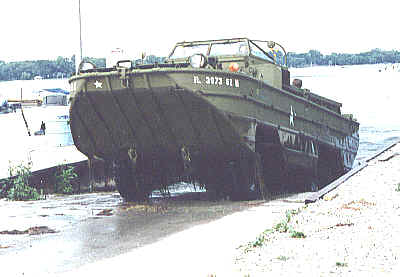
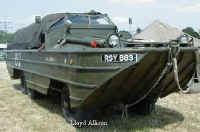
![[pictures - rear jpg]](../../images/tanks/DUKW.rear.jpg)
